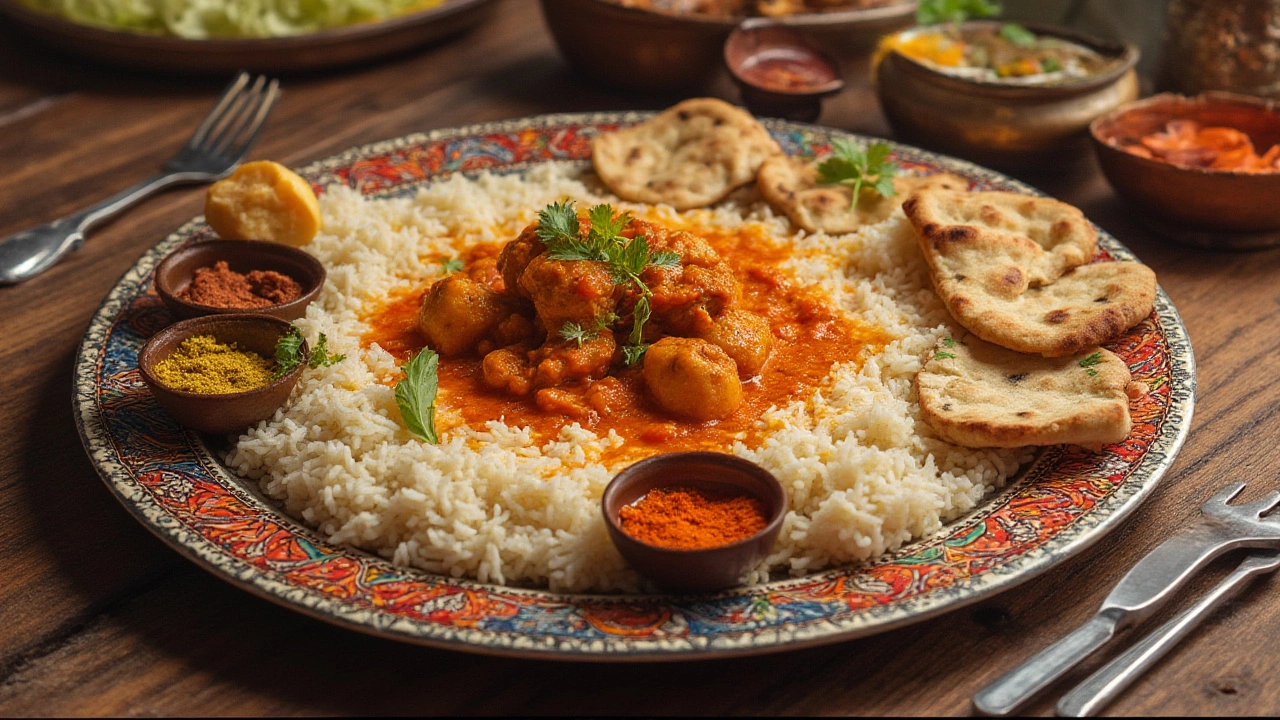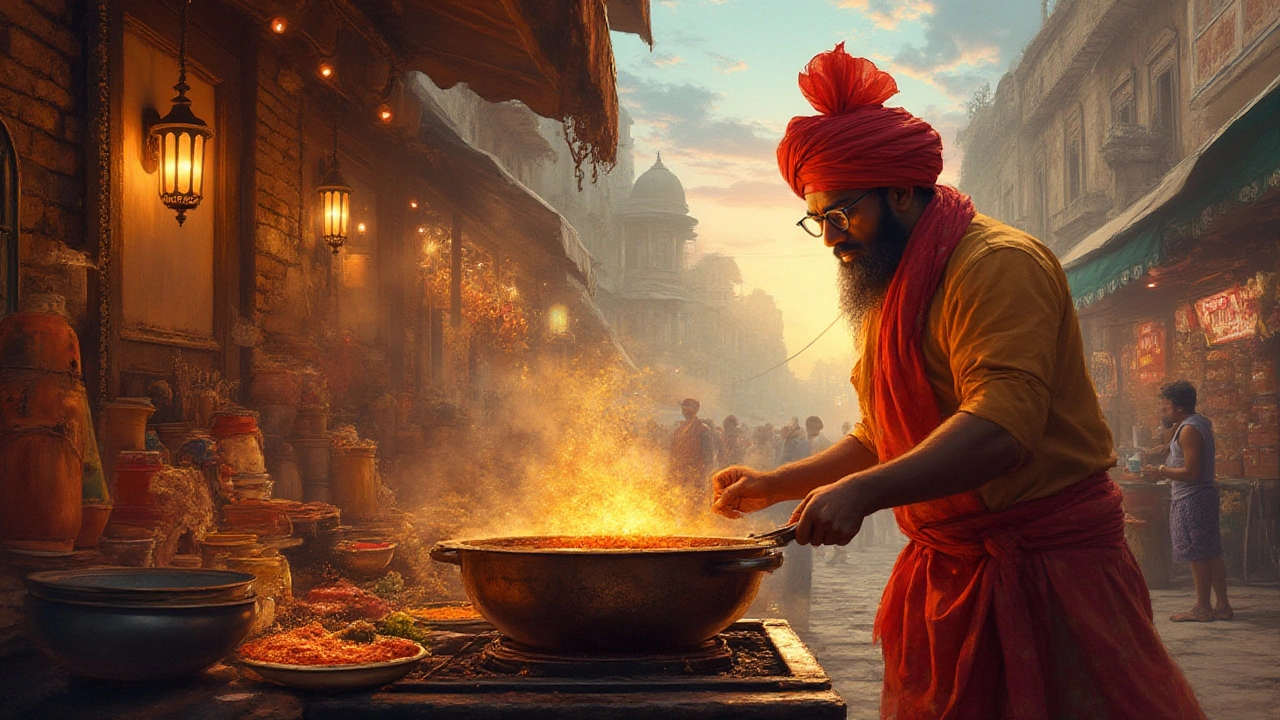25 Jul 2025
- 0 Comments
Ask anyone to name a classic Indian dish, and odds are you’ll hear "tikka masala" thrown in right away. It’s warm, creamy, and loaded with spices—easy to love. But if you scoop up a bite and wonder, “Wait, is tikka masala just curry with another name?” you’re not alone. It’s delicious, yes, but its story is tangled and full of surprises. Once, in my kitchen, my daughter Ivy asked, “Isn’t every saucy thing from India called curry?” Many people think the same thing. But there’s far more to this than meets the eye (or tastebud).
The Story Behind Tikka Masala: Not Just Another Curry
Picture this: Scotland, 1970s. Rain drizzles outside, but a new Indian restaurant is warming things up inside. Legend says a customer complains his chicken tikka (marinated, grilled chicken chunks) is too dry. The chef, thinking on his feet, whips up a tomato-cream sauce from a can of Campbell’s soup, adds a heap of spices, and pours it over. Bingo. Chicken tikka masala is born—kind of by accident, kind of as genius. This is not some ancient grandmother's recipe passed down in a faded spice box, but an answer for British taste buds craving sauce and comfort. Weird, right?
Here’s the twist: ask ten Indian chefs about tikka masala in India and you'll get confused looks. The dish, as most people know it, is all but invisible in India’s home kitchens. Instead, it sits in the “foreign favorites” section, mostly served for tourists. “Curry,” on the other hand, can mean countless things in India. It covers gravies as thick as butter or as thin as soup, yellow or red, fiery or mild. Tikka masala has a pop culture status that’s way out of proportion to its roots—more British than Indian, if we’re being honest.
Does that mean tikka masala isn’t authentic Indian food? Well, what’s “authentic,” really? Food evolves wherever it travels. About twenty years ago, Britain’s foreign secretary famously called chicken tikka masala a “true British national dish.” That's how much people in the UK love this stuff. But the dish’s real recipe is a mash-up: grilled chicken tikka, which Indian cuisine definitely owns, meets a creamy, tangy tomato sauce, shaped by British preferences. That’s not traditional Indian curry—at least not in the way a homestyle dal or vindaloo is. On Indian menus you’ll find “curries” everywhere, but tikka masala stands apart with its thick, smooth, orangey sauce and mild, almost sweet heat.
Here’s a quirky fact: actual “curry powder,” as we know it in the West, was invented by Brits, too—something to help those far from India cook up reminders of the Raj era. Real Indian curries rarely use any single “curry powder,” but rather combinations of whole spices, roasted, ground, and tweaked by each household. Tikka masala blends sweet and tangy—garam masala, cumin, coriander, sugar, cream or yogurt, and a lot of tomato. It’s curry-like, sure, but it’s its own thing, born from a blend of cravings and cultures on a rainy night.

What Actually Makes a Curry, and Where Does Tikka Masala Fit?
What is a curry anyway? That’s a rabbit hole. In India, “curry” isn’t a specific taste or ingredient. It just means a dish with a sauce or gravy, often eaten with rice or bread. The word “kari” in Tamil means sauce. There are coconut-laced curries in the south, like Kerala’s fish curry, or rich, brown, onion-heavy gravies like rogan josh in the north. No two are the same, because each region—sometimes each family!—does things its own way.
Let’s see how tikka masala actually stacks up against this huge background. Chicken tikka, the main event in tikka masala, starts with chunks of chicken marinated in yogurt, lemon, spices, and usually a dash of chili. They’re jammed onto skewers and charred in a tandoor, that signature Indian clay oven. Alone, that’s not a curry—just grilled meat. Then comes the big twist: those smoky pieces are dunked into a tomato-based sauce, silky with cream or butter. Some versions add fenugreek, others garlic and ginger, a pinch of sugar to round things out. The whole dish simmers until velvety and smooth. And here’s the kicker—it’s never super spicy. In fact, most families in India love more bite in their chicken gravies than typical tikka masala offers.
Compare that to classic “Indian curry”: heavy use of onions, maybe a base of tomatoes, green chilies, countless spices, sometimes coconut, yogurt, or mustard oil. It’s usually cooked all in one pot, just layering and simmering until you have deep flavors that soak into whatever protein or veggies you toss in. Curry dishes can be runny or thick, with whole spices or ground, and heat levels from mild to holy-cow. Tikka masala belongs in this club, but only barely. Its base is sweet and creamy, usually smooth—no chunky onions or lumpy potatoes, no whole dried chilis floating around.
It’s helpful to look at a quick table of comparison:
| Aspect | Typical Indian Curry | Tikka Masala |
|---|---|---|
| Sauce Base | Onions, tomatoes, or coconut, lots of whole spices | Cream or butter, tomato puree, garam masala, and dried fenugreek |
| Heat Level | Mild to fiery (often much hotter) | Mild, sometimes a little smoky |
| Texture | Chunky or smooth, depending on region | Always silky, smooth, and clingy |
| Protein | Chicken, lamb, fish, vegetables, paneer | Traditionally chicken tikka, but sometimes paneer |
| Origins | India (various regional roots) | Britain (with Indian influences) |
If you look closely, tikka masala almost acts like the "gateway curry" for people new to Indian flavors: creamy enough for cautious eaters, but still packed with a good hit of spice and aroma. My own Ivy, notorious for picking through spicy gravies and wrinkling her nose at anything “weird,” lights up at the first mouthful. The dish is proof that big flavors don’t always have to blister your tongue. That contrast is another reason why, as much as tikka masala sits among curries, it’ll always wear a different badge.
Another twist: the dish changes wildly depending on where you order it. In the UK, it’s famously orange and rich, balanced between tart tomato and sweet creaminess. In America, you might get more spice, even less cream, and sometimes a little coconut. In India—well, it’s there for tourists, but hidden in plain sight. Just because it’s on an Indian menu doesn’t make it the same as a good old North Indian murgh makhani (butter chicken), though the two share a family resemblance.
If you take away anything, let it be this: not all Indian curries are created alike. Tikka masala is curry-ish, but not your grandma’s curry. It’s an adopted child of everything that makes food travel so fascinating—blended traditions, a taste for comfort, and the real-life stories of kitchens halfway around the world.

Tips for Cooking (and Ordering) Tikka Masala Like a Pro
Think you can’t whip up a tikka masala at home? Trust me, you can. I’ve done it on busy weeknights when Ivy’s craving "saucy chicken" and the takeout menu’s nowhere in reach. Here’s how to get it close to the real thing, even if your kitchen lacks a tandoor or a giant spice cabinet.
- Marinate the Chicken: Mix plain yogurt, a bit of lemon juice, garlic, ginger, ground cumin, coriander, a pinch of cayenne pepper, and salt. Cube boneless chicken, toss it in, let it rest in the fridge for an hour—or even overnight.
- High Heat is Your Friend: Grill or broil your chicken pieces at a high temperature to mimic the char of a tandoor. You want them browned on the edges, not soggy or pale.
- Create the Signature Sauce: Start with butter in the pan. Sauté onions (finely chopped), then add garlic, ginger, and all those essential spices—garam masala, cumin, coriander, smoked paprika. The trick? Toast the spices until your kitchen smells like your favorite Indian takeout.
- Tomato Base: Add a can of pureed tomatoes (or fresh, blended very thin), and let it reduce until the color deepens and the oil starts to separate out. This stage is key. You’re building deep flavor here.
- Creamy Finish: Pour in heavy cream or coconut milk, and sprinkle dried fenugreek leaves (kasuri methi) if you can find them for that restaurant taste. Some recipes swirl in honey or sugar to smooth any tartness.
- Add the Chicken: Just before serving, add the grilled chicken and let it absorb some sauce, but don’t boil the cream or it’ll split.
There’s space for shortcuts (store-bought spice mixes, jarred tikka sauce), but the real game-changer is fresh marination and finishing with dried fenugreek leaves. Just don’t drown everything in cream—balance is the soul of the dish.
At restaurants, ask how spicy the tikka masala runs or if you can tweak the heat. Many British curry houses dial it way down, with extra sugar and even food coloring for that famous hue. Real tomato paste and fresh spices bring a natural, deeper color. Also, don’t skip the sides: naan or warm, fragrant basmati rice soak up the sauce perfectly. If you want to go healthier, swap cream for low-fat Greek yogurt and grill the chicken without extra oil.
If you’re in the mood for an experiment, swap out chicken for chunks of paneer (Indian cheese) and follow the same recipe. “Paneer tikka masala” is every bit as beloved among vegetarians—actually, Ivy says she sometimes likes it better! Mushrooms, tofu, even cauliflower can work too. There’s no one rule for what lands in your tikka masala pot. It’s a dish born from improvisation, after all.
Here’s a fun bite: According to a 2021 survey in the UK, over 23 million servings of chicken tikka masala were sold that year alone, making it one of the most ordered dishes from Indian takeout menus. Clearly, its popularity isn’t fading anytime soon. And that brings us back to the heart of the question: is tikka masala just curry? Not quite. It’s more like a love story—part Indian, part British, and all about how food changes with taste, time, and a little bit of luck.
